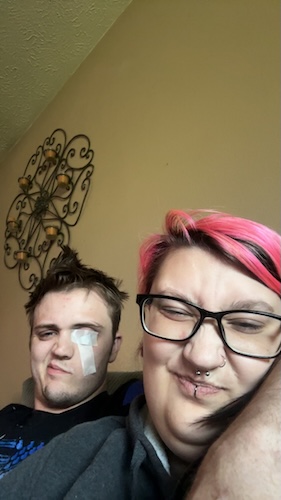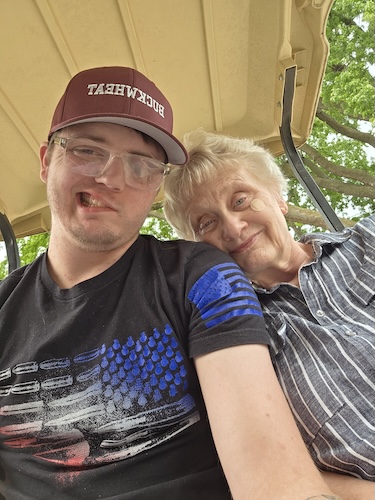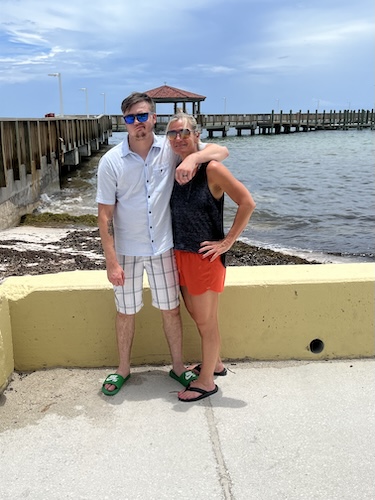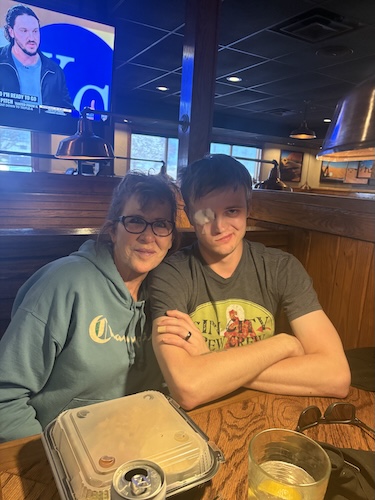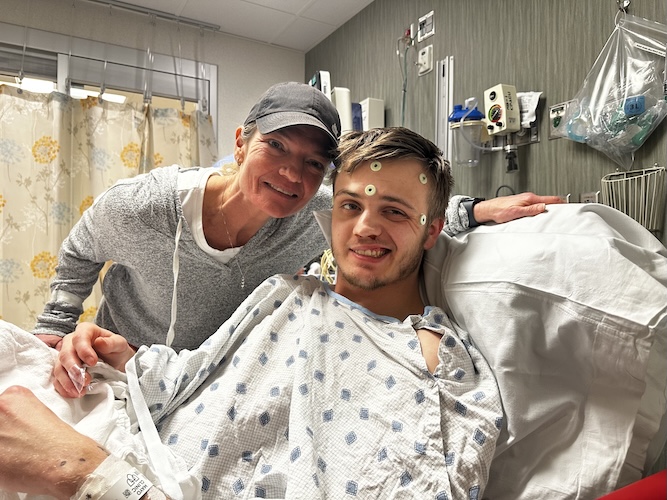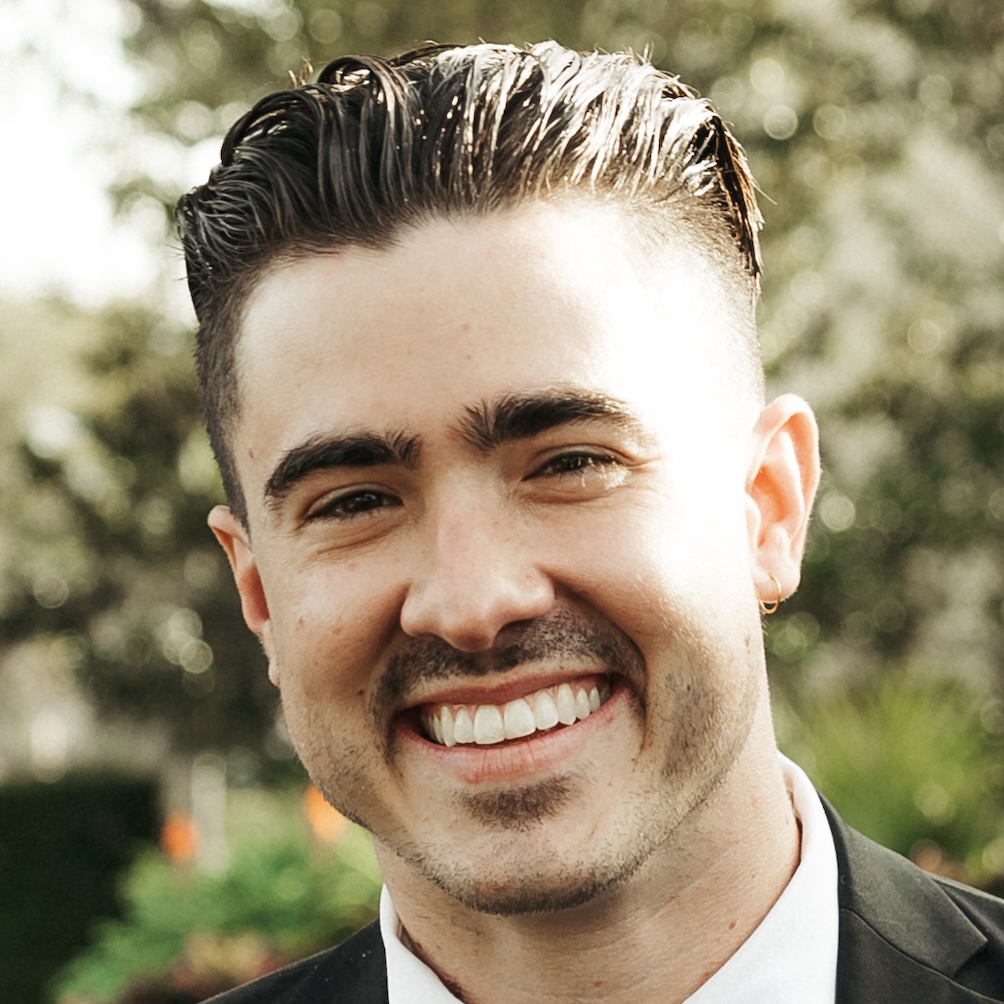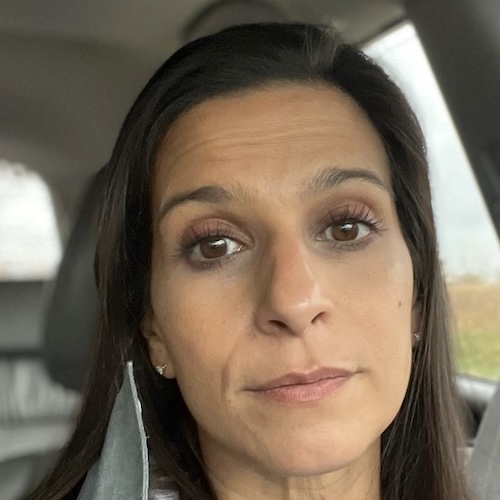Micheal Finds Hope with an Inoperable Brain Cancer by Joining a Clinical Trial
Micheal opens up about his experience with inoperable brain cancer. His story started in early 2025, when he began feeling random waves of nausea and dizziness, often after waking up or lying flat. At first, he thought he’d eaten something bad. Even his local doctor suspected simple balance issues caused by dislodged ear crystals. But when the right side of his face gradually weakened and his eyes began to twitch, he knew something more serious was going on.
Interviewed by: Nikki Murphy
Edited by: Chris Sanchez
After several MRIs, doctors confirmed that Micheal had a diffuse midline glioma (DMG) in his brain stem, a rare, aggressive type of brain cancer that, in his case, can’t be removed surgically. Hearing the diagnosis left him numb, yet he leaned on his family, faith, and humor to cope. His mom strongly encouraged a second opinion, which led them to Mayo Clinic, where he underwent a biopsy. While the procedure left him with facial weakness, partial numbness in his left arm, and some vision changes, Micheal remains mobile and independent.

Treatment has involved Micheal joining a clinical trial that’s focused on short rounds of radiation. Instead of doing six straight weeks of radiation, he receives two weeks at a time and then goes under observation. This approach allows his body to recover between treatments, which helps him both physically and mentally. He has had to deal with side effects like nausea, dizziness, and hair loss, but he’s grateful for the chance to keep moving forward.
Thanks to his experience, Micheal’s outlook on life has grown deeper and more meaningful. He takes time to appreciate small moments, like walking and noticing the world around him. He keeps his mental health in check by staying hopeful, joking with his mom, and setting goals for the future, like finally earning a pilot’s license when his vision improves. The advice he offers others is simple but powerful: never take life for granted, help others when you can, and always be the best version of yourself.
Micheal reminds everyone that having brain cancer doesn’t erase the possibility of joy, love, and purpose. Hope, for him, is waking up each day with the belief that there’s still life to live and a future to work toward.
Watch Micheal’s video and scroll through the transcript of his interview below to:
- Learn the subtle symptoms that can signal something far more serious than dislodged ear crystals
- Understand how Micheal turned a life-changing diagnosis into a story of hope
- Find out more about the clinical trial that gave him a chance to keep moving forward
- See the small daily moments that have brought Micheal joy in the face of brain cancer
- Read his simple yet powerful advice for living with purpose
- Name: Micheal J.
- Diagnosis:
- Brain Cancer (Diffuse Midline Glioma)
- Age at Diagnosis:
- 25
- Grade:
- Grade 4
- Symptoms:
- Vertigo
- Eye nystagmus
- Weakness on the right side of the face
- Dizziness
- Treatment:
- Radiation therapy, as part of a clinical trial
This interview has been edited for clarity and length. This is not medical advice. Please consult with your healthcare provider to make informed treatment decisions.
The views and opinions expressed in this interview do not necessarily reflect those of The Patient Story.
- My name is Micheal
- When I first noticed that something was wrong
- The moment everything changed
- My mom pushed for a second opinion
- What my biopsy did to me
- I decided to go on a clinical trial
- The side effects I’m experiencing while I’m on the clinical trial
- It’s hard to accept that surgery isn’t an option for me
- Cancer has changed my outlook on life
- Hope keeps me motivated
- My biggest advice to others
My name is Micheal
I was diagnosed with brain cancer, diffuse midline glioma, back in April of 2025.
When I first noticed that something was wrong
I first started noticing symptoms back in early February.
My family and I went to Minneapolis, Minnesota, to go to the Mall of America. We also saw a hockey game while we were up there. And that’s when I started waking up in the mornings and started randomly feeling very, very nauseous for some reason. I just thought I had eaten something bad. After we got back from Minnesota, I ended up calling in for an entire week, because I couldn’t lie flat any longer without getting a really bad dizzy spell. It was as if I stood still and spun in a circle and just stopped, and just let my equilibrium go.
I realized I couldn’t just keep calling it in. So I went to my local doctor down here. They marked it up as my ear crystals, the little ones in the ear that help out with balance and everything, getting dislodged. They gave me some medication for it, and it helped. But with me being a diesel mechanic and lying flat underneath trucks all the time, a creeper was not a whole lot of fun. I would get up off it and go straight to the trash can, essentially. I decided I couldn’t stand it anymore and realized there had to be something more that was going on.
Around the end of February or the start of March, the right side of my face started to get weaker, and I couldn’t smile or blink very well any longer on that side. I contacted my doctor about it, who took a look and said, “What I’m going to do is send you to the ENT, just to find out for sure if it’s your ear crystals or if it’s something more.” I went up to an ENT doctor in South Dakota, who ended up finding my eye nystagmus. If I looked completely to either side, my eyes would bounce back and forth.
They were the ones who told me I should get an MRI done. But I didn’t actually get it done until closer to April. That’s sad to say, but it’s just how things went.
The moment everything changed
When I went to the hospital and got an MRI, that’s when they found a mass.
We don’t have a whole lot of neurosurgeons down here in Sioux City. So they sent me to Mercy Hospital, where they have a neurologist. I did another MRI there, and they wanted to do surgery right away to get it out. I stayed the night. But the next morning, they said, “We’re going to send you up to Omaha, because we can’t really tell where this thing is. And they have better MRI machines there, too. And we don’t want to just go in and start trying to cut out something we can’t see.”
So they took me up to Omaha and did another MRI. And that’s how they found that the tumor was inside my brain stem. It’s called a DMG, which is a diffuse midline glioma. Essentially, it’s completely smooth. It has no borders, which means that it’s fused to my brain stem.
When they first walked in and told me about it, I was honestly very numb at first. I didn’t know what to think. And then I did something that scared many of the doctors and staff. I took off all the medical stuff that they hooked me up to so they could read my heart and everything. And then I looked at my mom and said, “I’m going for a walk.” I had my best friend, Kevin, and my wife, Becca, with me, and we ended up walking down to the church in the USMC. There, it all hit me, and I just broke down.
It took a lot to come to acceptance. It’s not a great prognosis, but we all had plenty of faith.
My mom pushed for a second opinion
I love my mom to death. She’s the one who said, “No, I can’t accept this.”
So after I went on my little journey, they had a couple of doctors come and find me, and they told me, “Hey, you can’t just walk off like that.” So we ended up coming home to Sioux City and my mom reached out to a couple of her friends who had cancer. They said, “Get to Rochester, go to Mayo, and get a second opinion there.” So my mom asks me out to breakfast the next day, at a little breakfast place here called Johnny Marr’s Really Good Breakfast, and she said, “Let’s just go up to Mayo, you know, they’re the best in the U.S. right now. What harm could it do?”
So we drove 4.5 hours that day and went into the emergency room, and we were there for a while. I think we got up to Rochester at around 8 p.m., and we didn’t leave until almost 2 or 3 a.m. They had a neurosurgeon in the ER there, named Sarah, a very nice lady. She said, “I’m going to send a personal message to Dr. Parney, one of the top neurosurgeons here, and we’re going to get something figured out in two days or so.
We got a call from Mayo saying that they wanted to schedule a biopsy. We set the appointment, went back to Mayo, and met Dr. Parney — he’s a very nice man. He said, “I can do the biopsy. There’s about an 85% chance of you coming out completely normal, like nothing’s happened. There’s also a 15% chance of some damage, and less than a 1% chance of death.”
I signed some papers, and he did the biopsy. They ended up grabbing two samples.
What my biopsy did to me
I experienced some aftereffects when I first woke up. I couldn’t move the right side of my jaw. Obviously, there was some Bell’s palsy going on on that side of my face. My right eye doesn’t close very well; it goes about halfway down and then stops. I can’t really move my right eyebrow very well. It took a little bit to regain some of the movements in my face. I can finally chomp down like normal now.
I have other aftereffects elsewhere in my body. My left arm, from about the pectoral muscle all the way to my fingertips, is still kind of numb. I’m starting to regain some feeling in my fingertips.
I’m still able to walk, talk, swallow — all those things that I would normally be able to do. It’s just those aftereffects mainly.
I decided to go on a clinical trial
The treatments for diffuse intrinsic pontine gliomas or DIPGs, which are another kind of brain cancer that can appear in the brainstem, and DMGs are fairly limited. There are a lot of ongoing clinical trials. My radiologist, Dr. Breen, told me that photon radiation is the best type of radiation therapy for these types of tumors.
When Dr. Breen and I were talking about treatment, he gave me options. The first was that I do the full six weeks of radiation in one go and see what happens. The second was that I take part in a clinical trial he organized.
The clinical trial would initially involve just two weeks of radiation, and then the medical team would go on observation after that. If the tumor grows or spreads, they hit it with another two weeks of radiation. This approach essentially allows you to prolong the treatment. If you do the entire six weeks, I believe you’ll need to take six months to almost a full year off just to let your body recuperate and heal.
When Dr. Breen brought up these options, my mom asked him, “If this were happening to your child, which one would you choose?” He said, “I would go for the clinical trial. A full six weeks of radiation on a very sensitive area of the body might have pretty significant effects.”
So we opted for the two weeks of radiation and to go in once a month for an MRI. We’d see how the tumor would do, and if it progresses or spreads, we’d hit it with another two weeks of radiation.
They’ve also been talking about this particular pill, but my doctor still has to talk to other doctors and see if I’m qualified for it.
The side effects I’m experiencing while I’m on the clinical trial
After the first two weeks of the trial, I was very nauseous. I was quite nauseous during the radiation as well. And the first couple of weeks after radiation are rough. They had told me in advance that the tumor might swell a little bit from the treatments, like a boxer’s eye that gets hit too many times. But they added that it would just be an initial thing, and then the swelling would just subside.
The first week I came home after the initial two-week period, I felt a lot of pressure in my head. I also had dizzy spells, which were pretty bad that first week. My hair also started falling out a little in the back of my head, where they were applying the radiation. But as time went on, my condition improved. I got fewer dizzy spells. My eye nystagmus has gotten better.
Thankfully, through all this, I’ve been able to keep my mobility as normal as possible. And overall, things have been okay.
It’s hard to accept that surgery isn’t an option for me
It’s hard. It’s very hard. I won’t lie to you.
I joined some Facebook support groups and interacted with other patients who didn’t have what I had, but had successfully had their tumors surgically removed. I feel that if the tumor’s removed, I would have a little bit more of a fighting shot, because there would be nothing there that would be pushing up against the optic nerves. I do know that they can recur, of course.
It’s still hard for me, but I’m slowly accepting it. I just keep praying and telling myself that I’ve been in my body for 26 years, whereas this thing has only been in my body for just a couple of months. I’m going to make sure this tumor dies.
Cancer has changed my outlook on life
I do have a better outlook on life now. It’s sad to say, but sometimes, it takes a life-changing event to make you realize the beauty of life in general. You get so stuck in your daily routine, from home to work and vice versa. Lately, I’ve been taking time to stop and smell the roses. Just going for walks outside, even at work, where we have this enormous parking lot for our trucks. Every morning, I’ll walk all the way down that lot and then walk all the way back to the shop, just looking around and admiring things.
I had always wanted to be a pilot. Obviously, with my vision having been affected, that’s been put on hold for a little bit. But that being said, I have a lot of options regarding what I can do. I’ve always been big on taking things apart and putting them back together, which is why I became a diesel mechanic. Way back when, I thought that I would do that for a while and then work on getting my pilot’s license. And then this happened.
But I’ve resolved that when my vision comes back, I’m going to go for my pilot’s license. It’s just that a couple of things have been stepped up a little bit more.
Hope keeps me motivated
At first, before my diagnosis, “hope” was just a word. You know, you hope for this or that to happen. But now, hope has taken on a different meaning for me. It’s what brings me some joy in my life. It’s what gives me the confidence to keep going.
It means a lot to me right now. It’s the reason I wake up in the morning. It’s the reason I keep fighting — the hope of living a long life, the hope of going to be able to spend time with my family.
It might seem like a joke, but my mom and I have been cracking jokes lately. For example, I told her, “I hope I bury you first before you bury me.” And she goes, “In all honesty, I hope the same thing.”
That’s what hope means to me. Being able to think about the future like there’s no tumor in my head. Being able to think about having kids, seeing my grandkids grow up. That’s what hope has meant to me lately.
My biggest advice to others
Don’t take life for granted. I definitely did before. I was one of those people who would just go, “Oh, I’ll do it later.” Don’t let a life-changing event, whether it be cancer, traumatic brain injuries, or whatever it is, let you put your life on hold because you think you have time.
Nobody ever expects to get cancer. I certainly didn’t. I was healthy, there was nothing wrong with me, and my bloodwork was all fine. And it all started just by getting dizzy, because I couldn’t lie flat on my back.
If you’re able to help someone out, go help them out. If you see that person on the side of the road with a flat tire and who doesn’t know how to change it, go help them. What’s the harm in helping them?
Always try and be the best version of yourself that you can be. Why live your life being a jerk? You can always take that with you. Nobody can ever take your personality away from you.

Inspired by Micheal's story?
Share your story, too!

